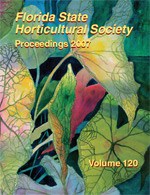Abstract
The Asian citrus psyllid (ACP), Diaphorina citri Kuwayama, is an invasive insect pest of citrus in Florida. It is an efficient vector of the bacterium Candidatus Liberibacter asiaticus, the causal organism of citrus greening or quot;huanglongbingquot; (HLB) disease. The pest was first detected in Florida in 1998 and is now present in all citrus growing areas throughout the state. HLB was first detected in Florida in 2005 and is spreading rapidly. Effective means of control are required to manage this pest and disease while maintaining ecological and economic sustainability. Natural mortality of uncaged ACP nymphs averaged 36% and 58% more than caged nymphs in 2005 and 2006, respectively, across three experiments per year. The increased mortality of unprotected nymphs was attributed mainly to the predation by ladybeetles, Curinus coeruleus, Olla v-nigrum, Harmonia axyridis, and Cycloneda sanguinea, as evidenced by their abundance on trees infested with psyllid immatures. Incidence of lacewings, Ceraeochrysa sp. and Chrysoperla sp., and the parasitoid Tamarixia radiata was very low. Foliar applications of broad-spectrum insecticides provided short-term (1-2 weeks) control of ACP and suppressed populations of ladybeetles. In contrast, drench applications of imidacloprid and other neonicotinoid systemics to young citrus trees were very effective in controlling ACP for about 2 months. However, similar application of a carbamate, oxamyl, was not very effective. Our results suggest that the contributions of biological control agents to mortality of ACP need to be conserved and enhanced for successful long-term management of pest and disease. Drench applications of neonicotinoid systemics provide long-term control to young trees but would be better made in late spring for best effect. Foliar application directed against immatures on young flush provide only short-term control at the cost of useful biological control agents, particularly ladybeetles. Therefore, foliar applications of insecticides are better targeted at ACP adults during the dormant winter period when ladybeetles and other beneficial insects are either cryptic or absent from the orchard.

